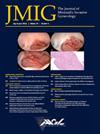A Reinterpretation of Paracolpium in Radical Hysterectomy: New Insights into Its Surgical Implication
IF 3.5
2区 医学
Q1 OBSTETRICS & GYNECOLOGY
引用次数: 0
Abstract
Objective
To reinterpret the surgical anatomy of paracolpium in radical hysterectomy and to explore its implications for the surgery.
Setting
The term “paracolpium” first defined by Fothergill in 1907, is essential in radical hysterectomy. However, several challenges remain unresolved. These include: (1) inconsistent terminology in relation to its defined attributes; (2) the lack of consensus on anatomical landmarks; (3) unclear associations with the cardinal and sacral ligaments; and (4) the critical implications and requirements of paracolpium resection in radical hysterectomy practices.
Participants
A patient in her 60s diagnosed with stage IB2 cervical cancer was enrolled in a clinical trial and assigned to the laparoscopic surgery group. A step-by-step, narrated video demonstration.
Interventions
During the procedure, post-excision of the uterosacral, cardinal, and vesicovaginal ligaments, we identified a ligament-like structure situated between the middle third of the vagina and the pelvic wall. We have termed this structure the “paracolpium ligament.” A detailed anatomical description was performed, outlining its crucial attachments:
• Medial attachment: middle third of the vagina
• Lateral attachment: tendinous arch of the pelvic fascia (TAPF)
• Cranial attachment: cardinal-uterosacral ligaments confluence
• Caudal attachment: pubococcygeus muscle fascia
• Dorsal: paravaginal space
• Ventral: pararectal space
To ensure a safe dissection, the paracolpium ligament was exposed by removing anterior and posterior fat tissue. The extent of surgical resection was adapted based on the tumor's location. Extensive resection of the paracolpium ligament was essential when the tumor was localized to one side of the vagina to ensure complete removal of the disease; otherwise, preservation of the ligament was considered feasible.
Conclusion
In this video, we meticulously name and define the “paracolpium ligament,” providing groundbreaking insights into its anatomical and surgical implications in radical hysterectomy. Our findings contribute to a better understanding of surgical anatomy for cervical cancer.
重新解读子宫根治术中的副溶血素:对其手术含义的新认识。
目的重新解释根治性子宫切除术中子宫旁的手术解剖,并探讨其对手术的影响:副阴道 "一词由 Fothergill 于 1907 年首次定义,在根治性子宫切除术中至关重要。然而,有几个难题仍未解决。这些挑战包括(1)与其定义属性相关的术语不一致;(2)解剖标志缺乏共识;(3)与贲门韧带和骶韧带的关联不明确;以及(4)根治性子宫切除术中子宫旁切除的重要意义和要求:一名被诊断为 IB2 期宫颈癌的 60 多岁患者参加了临床试验,并被分配到腹腔镜手术组。干预措施:在手术过程中,切除子宫骶骨韧带、贲门韧带和膀胱阴道韧带后,我们发现了位于阴道中三分之一与骨盆壁之间的韧带样结构。我们将这一结构称为 "阴道旁韧带"。我们对其进行了详细的解剖描述,概述了其重要的附件。
本文章由计算机程序翻译,如有差异,请以英文原文为准。
求助全文
约1分钟内获得全文
求助全文
来源期刊
CiteScore
5.00
自引率
7.30%
发文量
272
审稿时长
37 days
期刊介绍:
The Journal of Minimally Invasive Gynecology, formerly titled The Journal of the American Association of Gynecologic Laparoscopists, is an international clinical forum for the exchange and dissemination of ideas, findings and techniques relevant to gynecologic endoscopy and other minimally invasive procedures. The Journal, which presents research, clinical opinions and case reports from the brightest minds in gynecologic surgery, is an authoritative source informing practicing physicians of the latest, cutting-edge developments occurring in this emerging field.

 求助内容:
求助内容: 应助结果提醒方式:
应助结果提醒方式:


